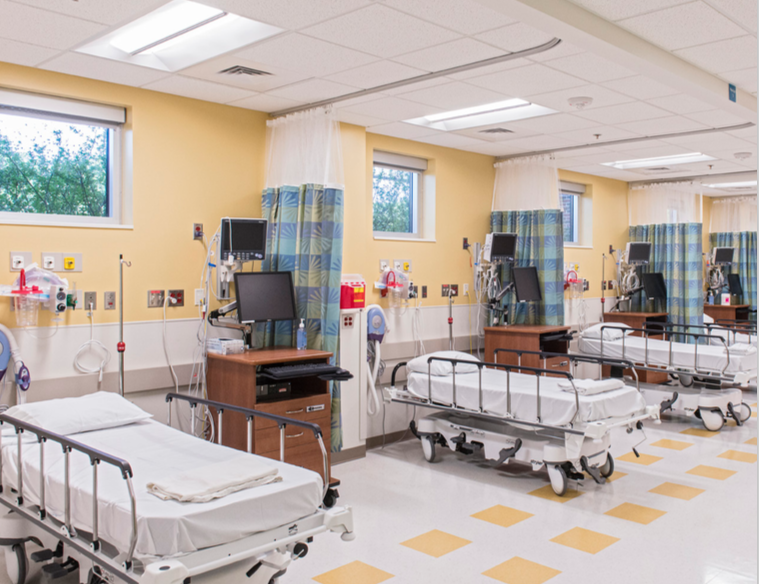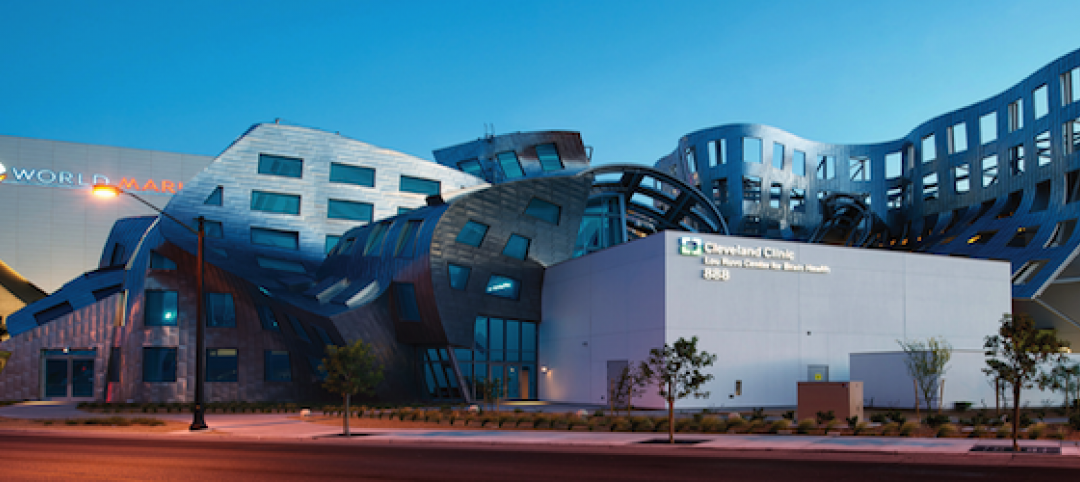Light plays an important role in human health and productivity, and there is no environment where these two factors are more dynamically connected than healthcare facilities. Hospitals are finding that upgrading to a modern LED lighting system can have a significant positive impact on almost every level of hospital function. Although LED lighting usually gets attention as a money-saving, energy-saving strategy—it can reduce lighting energy costs up to 70%—it can also bring measurable improvements to a facility’s performance in terms of patient recovery times, patient experience, medical staff performance, and staff job satisfaction. LED lighting may also contribute to reductions in accidents and errors; an increased sense of security for visitors and staff; and even better cleaning by maintenance staff. Those advantages can, in turn, yield financial benefits that go far beyond the cost of energy.
Today’s healthcare design is driven by several major pressures. Among the changes brought by the Affordable Care Act (ACA) was a link between patient satisfaction and the reimbursement rates that hospitals receive, making patient experience a bottom-line issue. Hospitals are also striving to control their spending through greater efficiency and a drive to get more usage out of limited space.
Surprisingly, better lighting can have impacts in all these areas of concern. Since most hospitals run 24/7, artificial lighting plays a crucial role in day-to-day operations. An LED smart lighting system can provide light that is not only better but also responsive to human needs and behaviors.
One can think of the hospital experience as a series of layers, each experienced by some or all of the stakeholders: patients, caregivers, family members, and non-clinical staff.
A Brighter Welcome
At healthcare facilities, exterior grounds and parking areas are typically what people encounter first. Dark or unevenly lit areas may be dangerous for security and increase the risk of slip/fall accidents. They can make arriving at the hospital stressful—bad for patient health and staff performance and productivity—and deter visitors, potentially impacting patient well-being and experience. Well-lit exteriors increase security, and the sense of security, so good lighting can be a sincere form of welcome.
The same may be said of reception areas, waiting rooms, and the corridors used by visitors and patients. A smart lighting system can adjust illumination levels according to time of day, helping maintain normal day/night body rhythms even in areas that don’t receive any natural light. Good lighting also improves wayfinding, one of the major challenges (and stressors) for hospital visitors and patients.
Light Can Help Healing
Studies over the past two decades have found abundant evidence of the connection between good lighting and patient healing. Other patient benefits may be less obvious. When McLaren Health Care System in Michigan upgraded 11 of its primary hospitals with smart LED lighting systems, they found they could reduce noise levels through control of the lighting. By dimming the lights in patient and visitor areas at certain times in the evening, they signaled that it was time to quiet down and allow patients to rest.
Doctors and nurses may also perform better under better lighting. Studies have shown that dim night-shift conditions make caregiving and medical decision-making more difficult. Since more than half of registered nurses are over the age of 50,[1] when the human eye requires three times as much light as a person aged 25, adequate light is vital for their job performance. Lighting can also affect performance and stress levels in the operating room, and error rates in dispensing medication. At McLaren Port Huron, the hospital’s housekeeping staff reported that with the improved lighting, they could “see what they’re cleaning,” a vital aspect of the fight against in-hospital infections.
Performance Boost
An LED lighting system can even increase usable space. With LED emitters (the “bulb” of an LED fixture) lasting for many years, extra spare bulbs do not have to be stocked to the extent as before, freeing up space for other types of storage. It could also mean drastically reduced maintenance times on fixtures, freeing staff for other tasks.
In healthcare, energy savings is only one of the ROIs of an LED lighting upgrade. Ultimately, the fundamental mission of the enterprise becomes more achievable. Many of the improvements affect bottom-line issues, too, by their impacts on efficiency, patient satisfaction, and job satisfaction.
References
[1] Lighting The Way: A Key To Independence, AARP 2001
Related Stories
| Jan 21, 2011
Research center built for interdisciplinary cooperation
The Jan and Dan Duncan Neurological Research Institute at Texas Children’s Hospital, in Houston, the first basic research institute for childhood neurological diseases, is a 13-story twisting tower in the center of the hospital campus.
| Jan 19, 2011
Biomedical research center in Texas to foster scientific collaboration
The new Health and Biomedical Sciences Center at the University of Houston will facilitate interaction between scientists in a 167,000-sf, six-story research facility. The center will bring together researchers from many of the school’s departments to collaborate on interdisciplinary projects. The facility also will feature an ambulatory surgery center for the College of Optometry, the first of its kind for an optometry school. Boston-based firms Shepley Bulfinch and Bailey Architects designed the project.
| Jan 19, 2011
New Fort Hood hospital will replace aging medical center
The Army Corps of Engineers selected London-based Balfour Beatty and St. Louis-based McCarthy to provide design-build services for the Fort Hood Replacement Hospital in Texas, a $503 million, 944,000-sf complex partially funded by the American Recovery and Reinvestment Act. The firm plans to use BIM for the project, which will include outpatient clinics, an ambulance garage, a central utility plant, and three parking structures. Texas firms HKS Architects and Wingler & Sharp will participate as design partners. The project seeks LEED Gold.
| Jan 10, 2011
Michael J. Alter, president of The Alter Group: ‘There’s a significant pent-up demand for projects’
Michael J. Alter, president of The Alter Group, a national corporate real estate development firm headquartered in Skokie, Ill., on the growth of urban centers, project financing, and what clients are saying about sustainability.
| Dec 17, 2010
ARRA-funded Navy hospital aims for LEED Gold
The team of Clark/McCarthy, HKS Architects, and Wingler & Sharp are collaborating on the design of a new naval hospital at Camp Pendleton in Southern California. The $451 million project is the largest so far awarded by the U.S. Navy under the American Recovery and Reinvestment Act. The 500,000-sf, 67-bed hospital, to be located on a 70-acre site, will include facilities for emergency and primary care, specialty care clinics, surgery, and intensive care. The Building Team is targeting LEED Gold.
| Dec 17, 2010
Arizona outpatient cancer center to light a ‘lantern of hope’
Construction of the Banner MD Anderson Cancer Center in Gilbert, Ariz., is under way. Located on the Banner Gateway Medical Center campus near Phoenix, the three-story, 131,000-sf outpatient facility will house radiation oncology, outpatient imaging, multi-specialty clinics, infusion therapy, and various support services. Cannon Design incorporated a signature architectural feature called the “lantern of hope” for the $90 million facility.
| Oct 18, 2010
World’s first zero-carbon city on track in Abu Dhabi
Masdar City, the world’s only zero-carbon city, is on track to be built in Abu Dhabi, with completion expected as early as 2020. Foster + Partners developed the $22 billion city’s master plan, with Adrian Smith + Gordon Gill Architecture, Aedas, and Lava Architects designing buildings for the project’s first phase, which is on track to be ready for occupancy by 2015.
| Oct 13, 2010
Prefab Trailblazer
The $137 million, 12-story, 500,000-sf Miami Valley Hospital cardiac center, Dayton, Ohio, is the first major hospital project in the U.S. to have made extensive use of prefabricated components in its design and construction.
| Oct 13, 2010
Hospital tower gets modern makeover
The Wellmont Holston Valley Medical Center in Kingsport, Tenn., expanded its D unit, a project that includes a 243,443-sf addition with a 12-room operating suite, a 36-bed intensive care unit, and an enlarged emergency department.
| Oct 13, 2010
Hospital and clinic join for better patient care
Designed by HGA Architects and Engineers, the two-story Owatonna (Minn.) Hospital, owned by Allina Hospitals and Clinics, connects to a newly expanded clinic owned by Mayo Health System to create a single facility for inpatient and outpatient care.
















